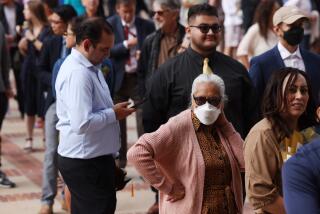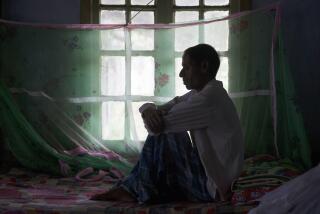County Failing to Control TB, Task Force Says : Health: Anti-tuberculosis efforts have declined as the number of cases has increased. Personnel shortages and low funding are blamed.
- Share via
Los Angeles County is failing in its efforts to control its growing tuberculosis epidemic, according to a task force of public health officials and physicians, who say that tuberculosis-control efforts have actually declined as cases have increased.
The group, including the head of the county’s tuberculosis-control program, said in a report to county health chief Robert Gates that disease and death rates are “unacceptably high” and will continue to rise unless tuberculosis-control efforts are intensified.
“Long-term decreases in resources and ever-increasing demands on the county’s health system have led to a decline in TB control efforts, which has likely contributed to the recent increases in TB cases,” the task force wrote in a report obtained by The Times.
The tuberculosis epidemic is the latest in a series of local and national outbreaks of diseases once believed to be under control and disappearing. In addition to tuberculosis, Los Angeles County has seen surges in syphilis and measles over the past four years.
At the root of the problem is inadequate support for public health programs such as screening and prevention, many experts say. Diseases have ended up spreading geometrically, forcing more and more public money to be spent treating and hospitalizing the sick.
“When you’re not taking care of business on a year-to-year basis, the problems pile up until they become crises,” said Dr. Shirley Fannin, who is in charge of communicable disease control for the county Department of Health Services.
The county’s tuberculosis rate has risen since 1988 to more than 2 1/2 times the national average--an increase traced largely to immigration, homelessness and the spread of the AIDS virus, which leaves infected people especially vulnerable to tuberculosis.
The rate, 24.1 cases per 100,000 people, is the highest seen here since the advent of modern drugs to prevent and treat tuberculosis, experts say. And the actual number of cases may exceed the official count by 30% to 100% because of inadequate screening and reporting.
Yet Los Angeles County is not unique: The tuberculosis rates in San Francisco, Oakland and Long Beach are equally high or higher. Tuberculosis rates also are high in, among other cities, Newark, New York and Miami, which also wrestle with immigration, homelessness and AIDS.
“There’s a lot of things we could be doing as a nation that we’re not doing because of a lack of resources,” said Dr. Dixie E. Snider, head of tuberculosis programs at the U. S. Centers for Disease Control. “Where those resources come from these days, everybody’s passing the buck back and forth.”
Tuberculosis is caused by bacteria spread by coughing or sneezing and breathed into the lungs. In most cases, a healthy person’s immune system thwarts the infection indefinitely. But in people with weakened resistance, the infection can spread and the disease take hold.
While county health officials say it is difficult to collect accurate numbers on tuberculosis deaths, the task force counted about 15,000 reported tuberculosis cases and 1,200 tuberculosis-related deaths in the county in the past decade.
People who have become infected, but do not yet have the disease, can receive drug treatment to prevent them from developing tuberculosis later. People who have so-called “active tuberculosis” also can be treated effectively with anti-tuberculosis drugs.
“We have tremendous technology and understanding of the disease,” said Dr. Paul T. Davidson, director of tuberculosis control for the county. “It’s something that we should be able to control. It’s something that we really can’t accept in the long run.”
But in the short run, the shortage of manpower and money has handicapped the county’s tuberculosis-control system, according to interviews with members of the tuberculosis-control task force formed by the county health department to advise county officials.
* Personnel shortages in the face of proliferating cases have forced county health officials to focus their efforts on people at the highest risk, leaving the rest to pay for treatment out of their own pockets or, more likely, risk falling ill.
* Understaffing in the county’s tuberculosis laboratory and the absence of up-to-date equipment have led to delays of several months in getting confirmation of a diagnosis and guidance on what drug might be effective.
* Backlogs in county health centers have forced some infected patients to wait two to four months before getting an appointment to begin preventive therapy. Such delays simply discourage many patients from returning to be treated, health officials say.
* The escalating cost of drugs used to treat tuberculosis and infection has left the county unable to comply with federal guidelines on preventive therapy. While the guidelines recommend that all infected people under 35 receive preventive therapy, the county can afford to give preventive therapy only to people under 19.
* While some district health offices with high tuberculosis case rates have wrestled with inadequate budgets for tuberculosis control, others with lower case rates have managed to accumulate more tuberculosis money, and appear to have spent it on other programs.
“The present efforts to control and eliminate TB in Los Angeles County are failing,” the task force concluded bluntly in its report, delivered in mid-February to health department. Health chief Gates forwarded the report Monday to the County Board of Supervisors.
The task force, made up of county public health officials, physicians and members of the Los Angeles County chapter of the American Lung Assn., recommended increasing the $15-million annual budget of the tuberculosis-control program by $6.7 million.
“(The county supervisors) may feel, ‘What the heck, it’s not as bad as AIDS, maternal health, something like that,’ ” said Dr. Wilbur Y. Hallett, a pulmonary disease specialist in Glendale and a member of the lung association board. “We want to try and convince them that if we don’t do something, it will become that bad.”
Tuberculosis: The Numbers
The rate of tuberculosis in Los Angeles County has risen since 1988 to more than 2 1/2 times the national average. Now a county task force says shortages of staff and resources are crippling efforts to control the disease. Here is a look at cases and the disease rate per 100,000 population:
The Nation Year* Cases Rate 1989 23,495 9.5 1988 22,436 9.3 1987 22,517 9.3 1986 22,768 9.4 1985 22,201 9.3
*1990 figures not available
L.A. County Year Cases Rate 1990 1,936 24.1 1989 1,681 21.2 1988 1,190 15.2 1987 1,302 16.9 1986 1,362 17.9 1985 1,495 19.9
Here is a look at tuberculosis case rates, per 100,000 population, by race and ethnicity in Los Angeles County over the last few years:
Race/Ethnicity 1985 1986 1987 1988 1989 1990 Non-Latino White 6.52 6.35 5.33 5.03 7.1 6.8 Latino 24.23 24.3 22.35 19.25 26.5 31.01 Black 24.64 22.01 25.38 24.86 29.4 35.68 Other 52.28 42.5 38 31.9 48.03 51.97
SOURCE: U.S. Centers for Disease Control, L.A. County Dept. of Health Services
More to Read
Sign up for Essential California
The most important California stories and recommendations in your inbox every morning.
You may occasionally receive promotional content from the Los Angeles Times.










